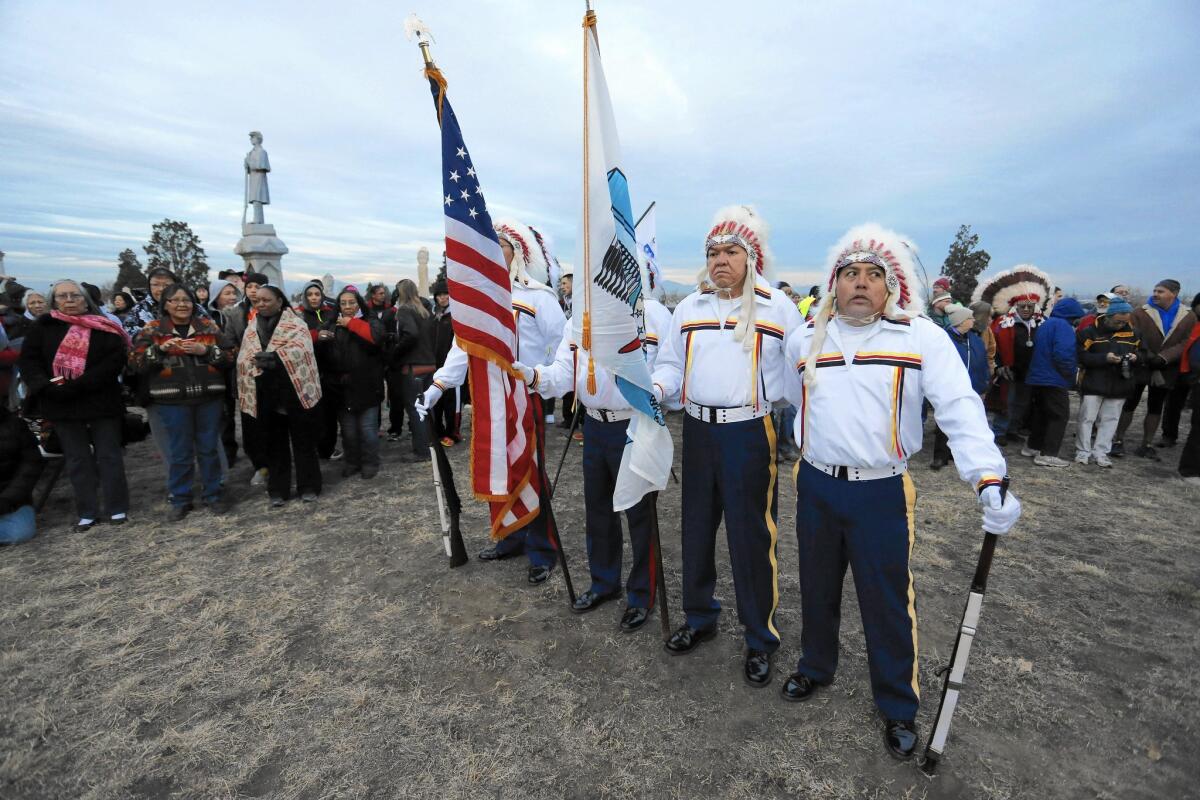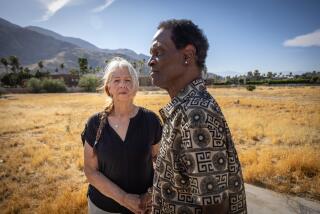Hero of Sand Creek Massacre in Colorado honored on 150th anniversary

- Share via
Reporting from Denver — As dawn broke, the first headstones began appearing against a backdrop of oil refineries and rolling freight trains.
Most were indistinguishable — knee-high, white, bearing spare inscriptions about those lying below.
Rhoda Hungary moved swiftly through Riverside Cemetery, home to more than 1,000 military graves, toward one marked simply “SS Soule Capt. 1 Colorado Cav.”
Small flags marked the spot and a letter dangled from the stone, revealing a damning secret.
“I tell you Ned it was hard to see little children on their knees have their brains beat out by men professing to be civilized,” wrote Capt. Silas Soule to Maj. Edward Wynkoop. “You would think it impossible for white men to butcher and mutilate human beings as they did there but every word I have told you is the truth which they do not deny.”
Hungary, 59, a member of the Northern Arapaho tribe from Wyoming, knew the story well.
“It wasn’t enough for them to kill us; they also had to mutilate the bodies,” she said.
It was a bitingly cold Wednesday morning in this scruffy sliver of Denver. Barbed wire fences and belching smokestacks surrounded the cemetery.
Lines of Cheyenne and Arapaho streamed toward Soule’s grave, paying silent tribute to the man who exposed the Sand Creek Massacre.
“He refused to fire,” said Otto Braided Hair, who helped organize events around the 150th anniversary of the Sand Creek Massacre last month. “If his men did fire, many of us wouldn’t be here today.”
The killing commenced on Nov. 29, 1864, when 700 members of the Colorado Territory Militia led by Col. John Chivington attacked a Native American encampment in southeastern Colorado, slaughtering between 150 and 200 Indians — mostly women, children and the elderly.
One of the Indian leaders, Chief Black Kettle, had been told to fly an American flag and white flags over his tepee to avoid an attack. But his signal was ignored and the soldiers rampaged through the camps for six to eight hours. Black Kettle survived, only to be killed by soldiers four years later in Oklahoma.
“In Colorado it was seen as a heroic battle against a group of terrorists,” said Colorado State Historian William Convery. “There was a war on the Plains and people had been whipped into hysteria.”
Chivington was hailed as a hero.
But Soule and fellow Cavalry officer Joseph Cramer knew better. They refused to take part in the attack and barred their men from shooting. Chivington threatened to court-martial them on the spot.
After the massacre, Soule, the son of abolitionists, wrote letters to his superiors exposing the horror in wrenching detail — fetuses ripped from mothers and scalped, scrotums turned into tobacco pouches, children shot for sport.
“I refused to fire and swore that none but a coward would, for by this time hundreds of women and children were coming toward us and getting on their knees for mercy,” Soule wrote.
Congressional investigations found Chivington guilty of perpetrating the massacre, but he didn’t go to prison. Soule was later shot dead in Denver, and his killers never brought to justice.
“I came to honor him because he stood with us,” Hungary said. “My great-great-great-grandfather Chief White Antelope was killed that day. They cut off his nose, his ears and private parts. They didn’t even leave the babies. It tears my heart.”
The 150th anniversary of the massacre has provoked wide-ranging introspection in Colorado. The United Methodist Church sent a delegation of 600 members on a pilgrimage to Sand Creek in June as an “act of repentance” for the conduct of Chivington, a Methodist minister. The University of Denver issued a report last month calling its founder, the late Gov. John Evans, culpable in the massacre; it said he “fanned the flames of war when he could have dampened them.”
There also are moves afoot to change the name of the nearly empty town of Chivington.
“The farther we get from Sand Creek, the more important it is to remember it,” Convery said. “Under the right or wrong conditions we could be right back there again.”
Many of the Indians at the cemetery took part in a 180-mile “healing run” between Denver and the Sand Creek Massacre National Historic Site, near Eads.
“People have been going to Sand Creek for years, but it’s all word of mouth until you set foot there,” said Wilma Blackbear, 30, a Cheyenne from Watonga, Okla., who made the run. “It’s a beautiful experience, almost an out-of-body experience.”
Heather Whitethunder, 33, said Soule’s courage offers a valuable lesson.
“It took just one person to change our entire history,” she said.
Soule’s great-great-nephew Byron Strom, 68, of Des Moines examined the tombstone.
“I’m proud that one of my relatives had the courage to act that way,” he said. “I can only hope if I were put in that position I would have done the same thing.”
As the ceremony closed, tribal elders daubed paint on the runners’ faces and offered blessings. A circle of men with long braided hair pounded a drum and sang. Women wrapped in blankets howled into the bitter sky.
Their collective voices, mournful yet strong, drowned out the passing commuters and trains.
“In the end it’s truly about forgiveness,” Hungary said. “But never forget.”
More to Read
Sign up for Essential California
The most important California stories and recommendations in your inbox every morning.
You may occasionally receive promotional content from the Los Angeles Times.










